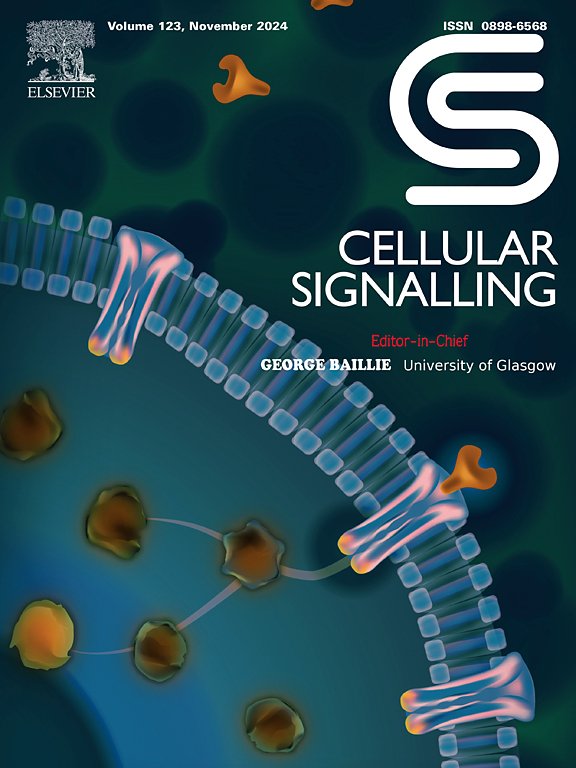A STAT1-GBP3-STING positive feedback loop governs inflammation, oxidative stress, and DNA damage to trigger acute aortic dissection
IF 3.7
2区 生物学
Q2 CELL BIOLOGY
引用次数: 0
Abstract
Acute aortic dissection (AAD) is a degenerative aortic remodeling disease characterized by exceedingly high mortality without effective pharmacologic therapies. Although oxidative stress, DNA damage, and inflammation are associated with AAD, the precise interplay among these responses has remained unclear. In this study, aortas from mouse AD models were subjected to integrative ATAC-seq and RNA-seq analysis. The pathogenic targets governing oxidative stress, DNA damage, and inflammation were identified by single-cell RNA sequencing, ROS staining, chromatin immunoprecipitation combined with PCR (ChIP-PCR), and co-immunoprecipitation (CoIP) analysis in the IFN-γ-stimulated vascular smooth muscle cells (VSMCs), mouse AAD model, and human ascending aortas. The transcriptional profiles of 191 differentially expressed genes revealed the IFN-γ response, oxidative stress-related NOD-like receptor, STING signaling pathways and marked elevation of STAT1, activated inflammation, DNA damage and ROS. Mechanistically, the activation of STAT1 binding on promoters of GBP3, H2aX and IFN-γ gene in nuclear as well as the interaction of GBP3 and STING protein in cytoplasm, determining a STAT1-GBP3-STING positive feedback loop triggering inflammation, DNA damage, and oxidative stress. Targeting this loop using STAT1 inhibitor Fludarabine impedes aortic degeneration while improving survival (60 % vs. 90 %) and reducing aortic expansion (2.34 ± 0.18 mm vs. 1.55 ± 0.15 mm) in the mouse AAD model. This study provides novel insights into a transcriptional program permitting aortic degeneration, warranting consideration of a critical target STAT1 for an anti-inflammation, anti-DNA damage, and anti-oxidative stress intervention as an attractive strategy to manage temporal-specific AD by modulating the STAT1-GBP3-STING positive feedback loop.
STAT1-GBP3-STING正反馈回路控制炎症、氧化应激和DNA损伤,从而引发急性主动脉夹层
急性主动脉夹层(AAD)是一种退行性主动脉重构疾病,其特点是死亡率极高,没有有效的药物治疗。虽然氧化应激、DNA损伤和炎症与AAD有关,但这些反应之间的确切相互作用尚不清楚。本研究对小鼠AD模型主动脉进行了ATAC-seq和RNA-seq综合分析。通过单细胞RNA测序、ROS染色、染色质免疫沉淀联合PCR (ChIP-PCR)和共免疫沉淀(CoIP)分析,在IFN-γ刺激的血管平滑肌细胞(VSMCs)、小鼠AAD模型和人升主动脉中鉴定氧化应激、DNA损伤和炎症的致病靶点。191个差异表达基因的转录谱揭示了IFN-γ应答、氧化应激相关的nod样受体、STING信号通路和STAT1的显著升高、激活炎症、DNA损伤和ROS。机制上,STAT1与细胞核中GBP3、H2aX和IFN-γ基因启动子结合,以及细胞质中GBP3与STING蛋白相互作用,形成STAT1-GBP3-STING正反馈回路,触发炎症、DNA损伤和氧化应激。在AAD小鼠模型中,使用STAT1抑制剂氟达拉滨靶向这一环可以阻止主动脉变性,同时提高生存率(60% vs. 90%)并减少主动脉扩张(2.34±0.18 mm vs. 1.55±0.15 mm)。这项研究为主动脉变性的转录程序提供了新的见解,值得考虑的是,通过调节STAT1- gbp3 - sting正反馈回路,将STAT1作为抗炎症、抗dna损伤和抗氧化应激干预的关键靶点,作为一种有吸引力的策略来管理时间特异性AD。
本文章由计算机程序翻译,如有差异,请以英文原文为准。
求助全文
约1分钟内获得全文
求助全文
来源期刊

Cellular signalling
生物-细胞生物学
CiteScore
8.40
自引率
0.00%
发文量
250
审稿时长
27 days
期刊介绍:
Cellular Signalling publishes original research describing fundamental and clinical findings on the mechanisms, actions and structural components of cellular signalling systems in vitro and in vivo.
Cellular Signalling aims at full length research papers defining signalling systems ranging from microorganisms to cells, tissues and higher organisms.
 求助内容:
求助内容: 应助结果提醒方式:
应助结果提醒方式:


